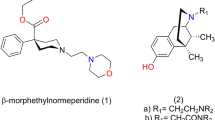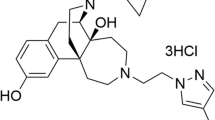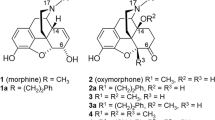Abstract
Pharmacological and biochemical studies of classical opiates and opioid peptide analogues have revealed the existence of several subclasses of opiate receptors1–5, among which the μ-, δ-, κ- and σ-receptors have been most widely discussed. The physiological roles of the different receptor classes and their structural characteristics remain to be elucidated. Recently, a cyclic analogue of enkephalin, H-Tyr-cyclo[-Nγ-D-A2bu-Gly-Phe-Leu-] (Fig. 1, compound I; A2bu represents α,γ-diamino-butyric acid), showing high potency in μ-receptor-selective bio- and binding assays has been described6. To assess the effect of the conformational constraint introduced by cyclization on opiate receptor selectivity, we have compared the cyclic compound I with its corresponding open-chain analogue, [D-Abu2,Leu5]enkephalinamide (Fig. 1, compound II; Abu represents α-aminobutyric acid), in bioassays based on inhibition of electrically evoked contractions of the guinea pig ileum and the mouse vas deferens, and in binding assays using μ-and σ-receptor-selective radiolabels. The differences in potency of the two compounds observed in the four assay systems suggest that the various opiate receptor subclasses have different preferences in terms of conformational properties of ‘complementary’ ligands.
This is a preview of subscription content, access via your institution
Access options
Subscribe to this journal
Receive 51 print issues and online access
$199.00 per year
only $3.90 per issue
Buy this article
- Purchase on Springer Link
- Instant access to full article PDF
Prices may be subject to local taxes which are calculated during checkout
Similar content being viewed by others
References
Martin, W. R., Eades, C. G., Thompson, J. A., Huppler, R. E. & Gilbert, P. E. J. Pharmac. exp. Ther. 197, 517–532 (1976).
Gilbert, P. E. & Martin, W. R. J. Pharmac. exp. Ther. 198, 66–82 (1976).
Lord, J. A., Waterfield, A. A., Hughes, J. & Kosterlitz, H. W. Nature 267, 495–499 (1977).
Chang, K.-J. & Cuatrecasas, P. J. biol. Chem. 254, 2610–2618 (1979).
Wolozin, B. L. & Pasternak, G. W. Proc. natn. Acad. Sci. U.S.A. 78, 6181–6185 (1981).
DiMaio, J. & Schiller, P. W. Proc. natn. Acad. Sci. U.S.A. 77, 7162–7166 (1980).
Hughes, J. et al. Nature 258, 577–579 (1975).
Roemer, D. et al. Nature 268, 547–549 (1977).
Handa, B. K. et al. Eur. J. Pharmac. 70, 531–540 (1981).
Pert, C. B. & Snyder, S. H. Molec. Pharmac. 10, 868–879 (1974).
Bowen, W. D., Gentleman, S., Herkenham, M. & Pert, C. Proc. natn. Acad. Sci. U.S.A. 78, 4818–4822 (1981).
Martin, W. R. in The Bases of Addiction (ed. Fishman, J.) 395–410 (Dahlem Konferenzen, Berlin, 1978).
Veber, D. F. et al. Proc. natn. Acad. Sci. U.S.A. 75, 2636–2640 (1978).
Meyers, C. A. et al. Proc. natn. Acad. Sci. U.S.A. 77, 577–579 (1980).
Chipens, G. I. et al. Int. J. Peptide Protein Res. 18, 302–311 (1981).
Krogsgaard-Larsen, P., Johnston, G. A. R., Lodge, D. & Curtis, D. R. Nature 268, 53–55 (1977).
DiMaio, J., Nguyen, T. M.-D., Lemieux, C. & Schiller, P. W. J. med. Chem. (submitted).
Schiller, P. W., Eggimann, B., DiMaio, J., Lemieux, C. & Nguyen, T. M.-D. Biochem. biophys. Res. Commun. 101, 337–343 (1981).
Paton, W. D. M. Br. J. Pharmac. 12, 119–127 (1957).
Schiller, P. W., Lipton, A., Horrobin, D. F. & Bodanszky, M. Biochem. biophys. Res. Commun. 85, 1332–1338 (1978).
Hughes, J., Kosterlitz, H. W. & Leslie, F. M. Br. J. Pharmac. 55, 541–546 (1975).
Waterfield, A. A., Leslie, F. M., Lord, J. A. H., Ling, N. & Kosterlitz, H. W. Eur. J. Pharmac. 58, 11–18 (1979).
Kosterlitz, H. W. & Watt, A. J. Br. J. Pharmac. 33, 266–276 (1968).
Cheng, Y. C. & Prusoff, W. H. Biochem. Pharmac. 22, 3099–3108 (1973).
Author information
Authors and Affiliations
Rights and permissions
About this article
Cite this article
Schiller, P., DiMaio, J. Opiate receptor subclasses differ in their conformational requirements. Nature 297, 74–76 (1982). https://doi.org/10.1038/297074a0
Received:
Accepted:
Issue Date:
DOI: https://doi.org/10.1038/297074a0
This article is cited by
-
Comparison of cyclic ?-opioid peptides with non-peptide ?-agonist spiroindanyloxymorphone (SIOM) using the message-address concept: A molecular modeling study
Journal of Computer-Aided Molecular Design (1996)
-
A proposal for the molecular basis of ? and ? opiate receptor differentiation based on modeling of two types of cyclic enkephalins and a narcotic alkaloid
Journal of Computer-Aided Molecular Design (1991)
-
Comparative conformational analysis of % MathType!MTEF!2!1!+-% feaafeart1ev1aaatCvAUfeBSjuyZL2yd9gzLbvyNv2CaerbuLwBLn% hiov2DGi1BTfMBaeXatLxBI9gBaerbd9wDYLwzYbItLDharqqtubsr% 4rNCHbGeaGqiVu0Je9sqqrpepC0xbbL8F4rqqrFfpeea0xe9Lq-Jc9% vqaqpepm0xbba9pwe9Q8fs0-yqaqpepae9pg0FirpepeKkFr0xfr-x% fr-xb9adbaqaaeGaciGaaiaabeqaamaabaabaaGcbaGaae4waKaaGi% aabseakiaab2cajaaOcaqGqbGcdaqgaaqaaKaaGkaabwgacaqGUbGc% daahaaWcbeqaaiaabkdaaaGccaGGSaqcaaIaaeiraiaab2cajaaOca% qGqbGaaeyzaaWcbaaakiaawYa7aKaaGkaab6gakmaaCaaaleqabaGa% aeynaaaakiaac2faaaa!475D!\[{\text{[D - P}}{\text{n}}^{\text{5}} ]\] enkephalin (DPDPE): A molecular mechanics study
Journal of Computer-Aided Molecular Design (1991)
Comments
By submitting a comment you agree to abide by our Terms and Community Guidelines. If you find something abusive or that does not comply with our terms or guidelines please flag it as inappropriate.



